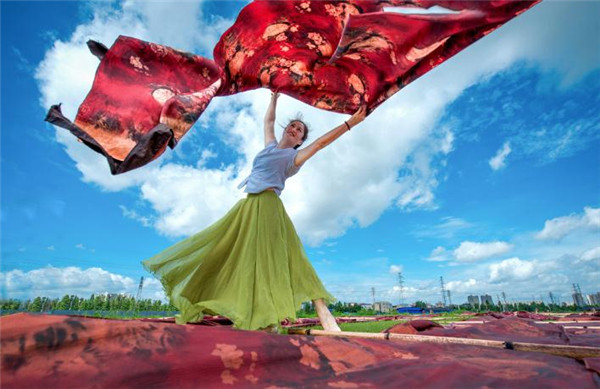As one of the important origins of Lingnan culture, Foshan has many cultural symbols. The intangible cultural heritages in Foshan like the famous Cantonese opera, paper cutting, wood engraving pictures, Xiangyun Silk still shine brightly with the preservation of generations of inheritors after so many years.
From this January, Foshan News Network will present a new series of Foshan ICH • Charming Lingnan. Foshan national intangible cultural heritages will be introduced to people all over the world through pictures and English descriptions, displaying the charm of traditional Foshan culture.
Shunde, Foshan, Guangdong, is the production and inheritance base of Xiangyun Silk (also known as gambiered gauze). Under the sunshine, Xiangyun Silk tells its story like a poem, and shows its lively color like a painting.

Colorful Xiangyun Silk at the drying yard in Lunjiao, Shunde. (Photo by Chen Jinde)

Colorful Xiangyun Silk at the drying yard in Lunjiao, Shunde. (Photo by Chen Jinde)
Dyeing
Xiangyun Silk is the only silk fabric dyed with pure plant in Chinese silk industry. It’s actually dyed with the juice precipitated by Dioscorea Cirrhosa Lour. Xiangyun Silk is known as "soft gold".

The raw material of Xiangyun Silk is Dioscorea Cirrhosa Lour. (Photo by Li Liwen)

Dyeing is the first step of making Xiangyun Silk. (Photo by Yang Weihong)
Drying
Drying plays an important role in the production process of Canton Embroidery, and it has a high requirement for grassland and sunlight. The grass should often be trimmed, and Xiangyun Silk should be aired at a time when the sun is sufficient.

The worker is putting the dyed Xiangyun Silk in the sun. (Photo by Gao Bo)

The workers are tidying up and drying Xiangyun Silk. (Photo by Cui Lingwen)

When the wind blows the Canton Embroidery, it is like a beautiful rainbow. (Photo by Li Liwen)
Dyeing Mud
Dyeing mud is one of the most important steps to make the Xiangyun Silk. The mud is not the river mud that is polluted, but is a mineral-rich river mud. After the river mud and Dioscorea Cirrhosa Lour juice are fully reacted, Xiangyun Silk will produce colloid, so that the color does not fade.

At 4:20 a.m., workers begin to prepare for dyeing mud for Xiangyun Silk. (Photo by long Xiang)

The workers are dyeing Xiangyun Silk with mud that is rich in minerals. (Photo by Xu Yijun)
Washing

Workers are washing the dyed Xiangyun Silk. (Photo by Xu Yijun)
Collecting

Workers are folding the dried Xiangyun Silk. (Photo by Xu Yijun)

After more than 30 processes, the precious Xiangyun Silk came into being. They should be stored for 3 to 6 months before cutting. (Photo by Li Liwen)
Dancing Canton Embroidery

Performer is dancing with Xiangyun Silk. (Photo by Cui Lingwen)
Source | Foshan News Network


